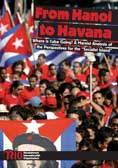




 In the mid 1980s, the Cuban leadership introduced a campaign of rectificación and recentralization of the economy. Going against the zeitgeist of Michail Gorbatchov’s Perestroika programm, this might have saved the Cuban system from complete collapse when the Council for Mutual Economic Assistance fell apart and with it a big part of Cuba’s foreign trade[20]. The response to this was the “Special Period in Times of Peace”, which began on July 26, 1990. By 1993, Cuba’s GDP had sunk by 30% – oil imports even by 70%[21].
In the mid 1980s, the Cuban leadership introduced a campaign of rectificación and recentralization of the economy. Going against the zeitgeist of Michail Gorbatchov’s Perestroika programm, this might have saved the Cuban system from complete collapse when the Council for Mutual Economic Assistance fell apart and with it a big part of Cuba’s foreign trade[20]. The response to this was the “Special Period in Times of Peace”, which began on July 26, 1990. By 1993, Cuba’s GDP had sunk by 30% – oil imports even by 70%[21].
A constitutional reform in 1992 allowed foreign investment on the island under certain conditions. The new joint ventures (empresas mixtas) are run by the Cuban state and multinational corporations. The first such business was opened by a tourism company from the former colonial power Spain – by 2005, Spain had the largest number of joint ventures at 100[22].
In 1993, some state farms were transformed into farmers’ cooperatives and small businesses were legalized. By 2001, there were 150,000 legal small businesses on the island, operating under many restrictions: For example, a paladar, a small, private restaurant, can only serve twelve customers at a time[23]. In addition, all kinds of black market businesses serve food, sell souvenirs, rent videos or do any of a thousand other jobs. (This includes the widespread phenomenon of prostitution, which had all but disappeared by 1990 but reemerged with the begin of the “Special Period”[24].) Both sectors together represent an important petty-bourgeois sector of the economy.
Food distribution has been increasingly privatized. It was organized almost entirely by the state until 1995[25], but by 2000, more than half of food was distributed by the private sector[26]. Now the government food ration suffices for, at most, two weeks of each month – theft and trading on the black market are a necessity for the population to meet their basic needs.
Also in 1993, the US dollar was legalized. To suck up as much foreign currency as possible, the state opened up shops selling foreign products in dollars. Cubans could acquire dollars in several ways: from remittances from relatives abroad, from business dealings with tourists and also from corruption. Starting in 1994, the state paid bonuses for state employees in dollars, above the normal wage in pesos. By 1999, roughly a third of the islands’ workers profited from these bonuses[27]. Of course this is a far cry from Che Guevara’s ideas of “moral incentives”!
Interestingly, sugar is no longer the king of the Cuban economy. In 2006, Cuba hosted two million foreign tourists for the first time – that sector employs 80,000 workers directly and according to some estimates a further 200,000 indirectly[28]. In 2000, tourism brought in 1.9 billion dollars, whereas exports (including sugar and nickel) only brought in 1.5 billion[29]. Cuba’s sugar harvest is currently reaching historical lows, below anything in the last hundred years.
Notes:
20. William H. LeoGrande: “The ‘Single Party of the Cuban Nation’ Faces the Future”. In: Max Azicri/Elsie Deal [editors]: Cuban Socialism in a New Century. Adversity, Survival and Renewal. Gainsville 2004. P. 186.
21. Philip Brenner [et al.] [editors]: A Contemporary Cuba Reader. Reinventing the Revolution. Lanham 2007. P. 1.
22. Marguerite Rose Jiménez: “The Political Economy of Leisure”. In: Brenner: Cuba Reader. P. 148.
23. Juliana Barbassa: “The New Cuban Capitalist”. In: Lydia Chávez [editor.]: Capitalism, God and a Good Cigar. Cuba Enters the Twenty-First Century. Durham/London 2005. P. 19-21.
24. Jiménez: Leisure. P. 150.
25. Minor Sinclair/Martha Thompson: “Agricultural Crisis and Transformation”. In: Brenner: Cuba Reader. P. 163.
26. José Luis Rodríguez García: “The Road to Economic Recovery”. In: Azicri: Socialism. P. 156.
27. Ebd. P. 155.
28. Jiménez: “Leisure”. P. 146-147.
29. Andrew Zimbalist: “Measuring Economic Performance. Strong and Weak Prospects.” In: Azicri: Socialism. P. 172.
Leave a Reply
